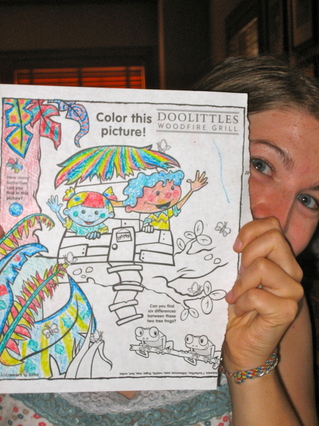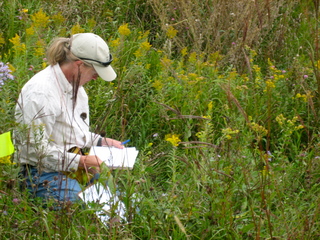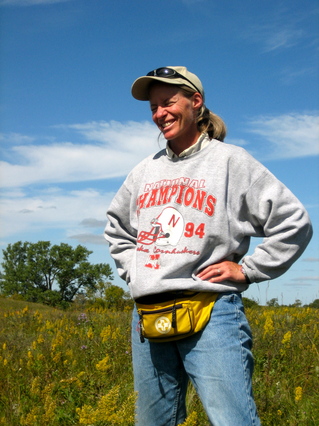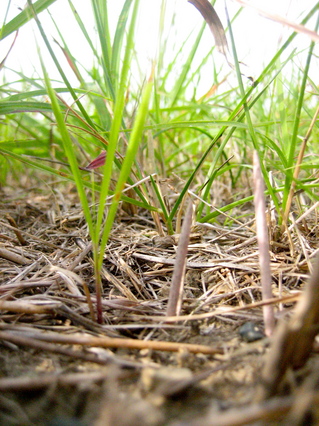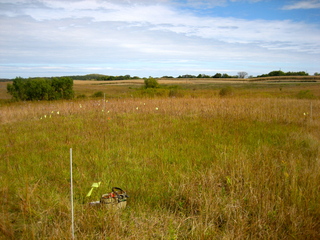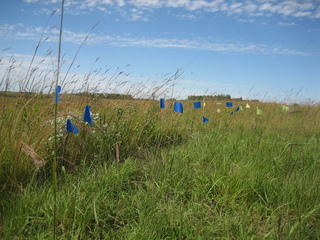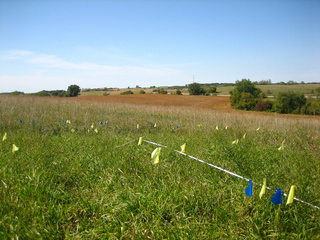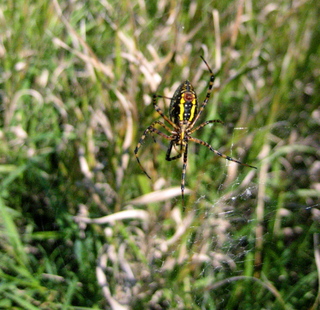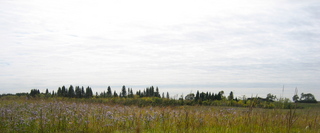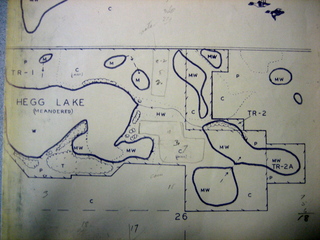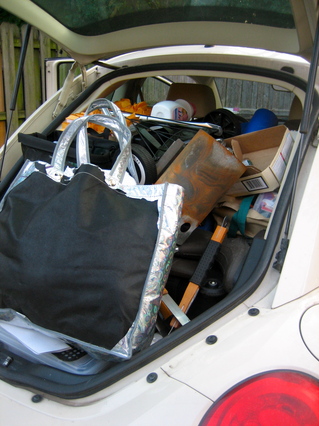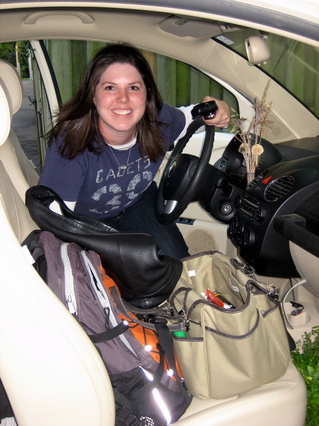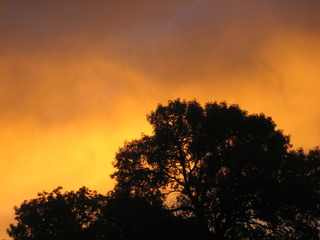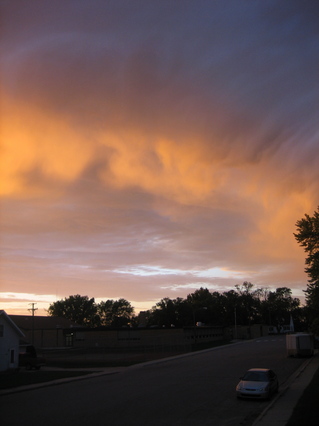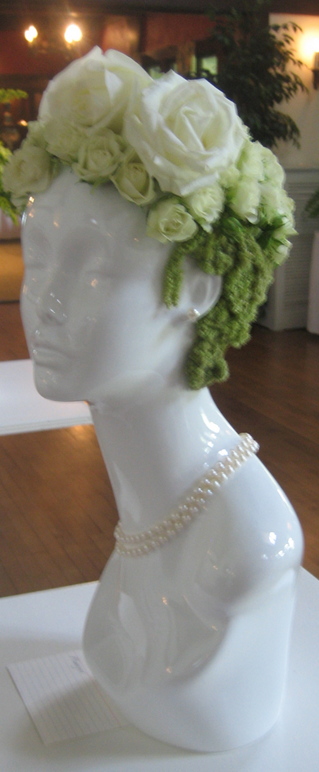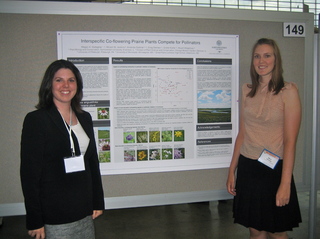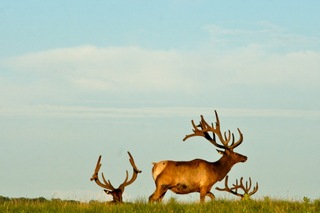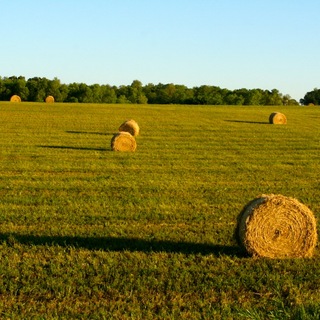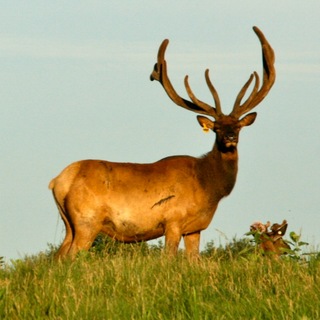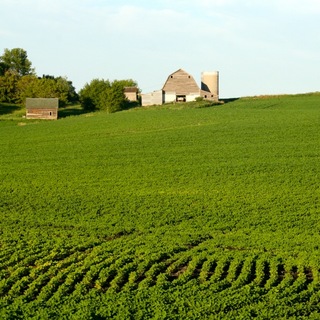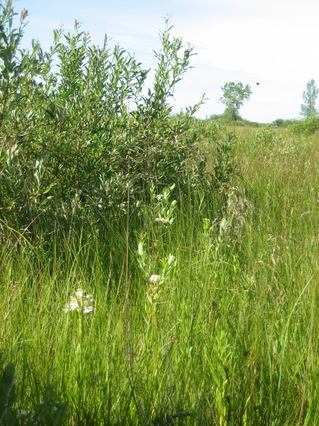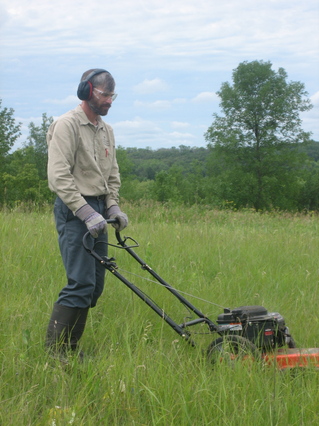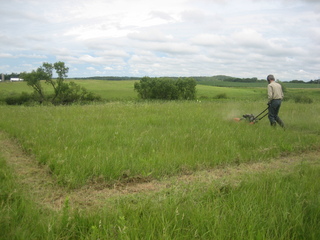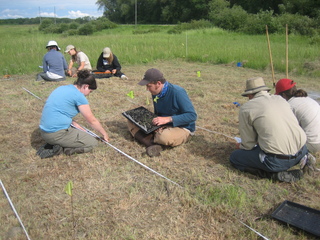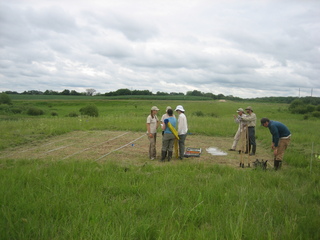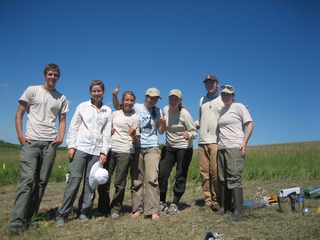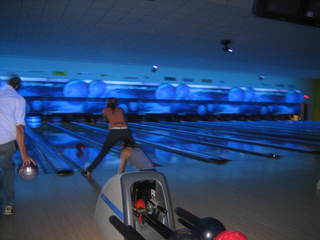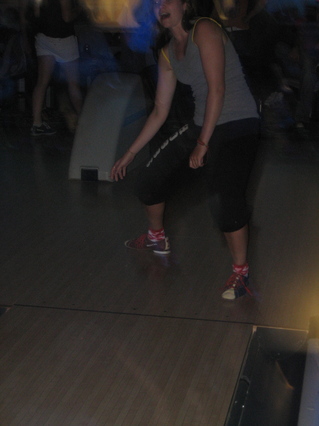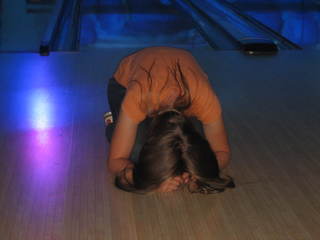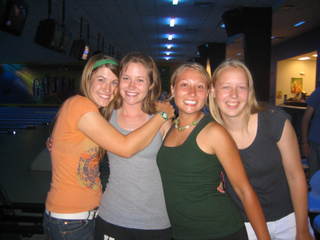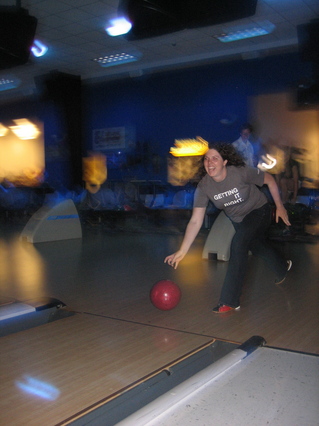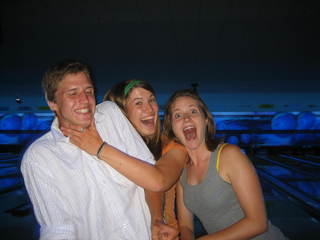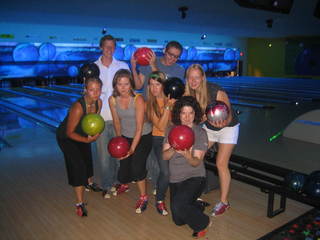Voila the Echinacea 2010 Cookbook!
-Kate
|
||||
CategoriesExperiments
|
Wow! This month has just flown by! It’s hard to believe that September is almost over, and so many things have happened. Let me explain. No. It’s too much. Let me sum up: Josh and Hillary had their last day on the 3rd. But before they left we: visited the county fair and saw lot’s of farm animals, visited Morris, and went out to a restaurant for dinner where Hillary created some beautiful art (see picture below). I think she has a great future in the creative arts. After they left, Amy and I worked very hard on seedling rechecks. Unfortunately, the weather was not always in our favor, but we persevered: I also spent a significant amount of time gathering my final data for both my seedlings and plugs: I finished my last bit of measuring on the 14th. Bob Mahoney’s site has a ton of spiders. I’m not usually very squeamish, but these guys are huge! So as you all know (I hope), I planted both plugs and seeds at three locations in Kensington: Hegg Lake, Runestone, and Bob Mahoney’s. One of the goals that I had for the summer was to find out what I could about these three locations. The site history; what they were planted with and how they were managed. After I finished my final data collection, I was finally able to take some time away to focus on these questions. I visited the Wildlife Management Office (Runestone) in Fergus Falls and the Department of Natural Resources (Hegg Lake) office in Glenwood. In Fergus, I met with Kevin Brennan and Chad Raitz, who were both very knowledgeable and helpful. I learned that the Runestone site is old farmland that was purchased in 1988. It was planted with corn in 1989, and with soy in 1990 and 1991, before being seeded with natives. The warm season grass seeds were harvested from a number of sites within a 50mi radius of Runestone, but the cool season grasses were purchased. Apparently, the gov’t offices can usually harvest their own warm season grasses, but have a harder time with cool season grasses because 1) their harder to find and 2) they don’t have the manpower off-season to go collect the seed. I also learned that in general, they don’t usually plant forbs, or rather they don’t go out and harvest forbs specifically. They do bulk harvests at prairie remnants and previous restorations and if they get forb seed that’s great, but they don’t go out specifically to gather forb seed. This makes me wonder about how successful a prairie restoration can be if the entire community assemblage isn’t present. How often do they go to harvest, what species are they missing? etc. Chad also told me that some of their harvesting sites are now being invaded with Tansy and parsnip, and so they can’t use those sites anymore. But he didn’t think they were working to fend off the invasion, again he sited lack of manpower. Kevin Kotts at the DNR was also very helpful. He pulled out all of the files on the Hegg Lake site and let me wade through them. I learned a lot about the DNR, their management practices, and a bit about the politics involved in creating a wildlife refuge like Hegg. It turns out that the DNR’s purchase of the Hegg Lake site was quite controversial. The land was purchased in two parts, but the bulk of it was sold by Mel Hagen for $12,500 back in 1961. Another smaller section was purchased in 1962 from a Mrs. Viola Brown. However, before the land could be purchased, the sale had to be approved by the Douglas County Commissioners, and it wasn’t. Much of the land at Hegg was in crop production, and thus was on the tax lists, and the commissioners didn’t want to loose productive land to wetland restoration. One commissioner claimed that Douglas County already had “enough ducks”! John Scharf, the Area Game Manager for the DNR, had to work for a solid year to get the purchase approved. He wrote in one of his many letters that, “their narrow-minded approach left [him] in a foul mood.” (Pun intended?) Once they had the land, the DNR focused more on restoring the wetlands than the upland prairie areas at Hegg. Much of the site actually remained cropland for years after the initial purchase. The area where my site was located was finally restored in 1998 and planted with native seed harvested in the Fergus Falls area, at least that’s what Kevin thinks. Despite all their files on the subject, there wasn’t any firm paperwork on the actual restoration of that portion of Hegg. Nevertheless, I got took some interesting pictures and found out some interesting information about the site. On September 17th, I was able to drive into Minneapolis-St.Paul to visit the University of Minnesota one last time. I met with a number of really interesting professors there. University of MN definitely has a great faculty and some very interesting programs! After my meetings, I met Amanda (from 2009 crew) for dinner. It was great to catch up with her and also to discuss the pollinator study we’ve both been working on for over a year now. We will get this project published by hook or by crook! That night Amy let me crash at her place before driving back to Kensington. I finally met Brad! I felt like I knew the man, but I’d never actually met him. I also met Mr. Bird, and let me tell you, that was an honor! Mr. Bird is quite the personality. So, THANK YOU AMY AND BRAD for letting me spend the night! On September 20th I drove back to Chicago! I was surprised to find temperatures in the 80s here in Chicago, when I had been, slowly, getting used to temperatures in the 50’s and 60’s up in MN. Here’s my car all packed for the way home:
Two last pictures of a beautiful MN sunset: Thus ends a very successful field season! A .csv file with the list of leftover 14000 tags. These tags were not put out in 2009. Kate Gallagher | August 18th, 2010 | Category: reference | One comment 1) Hillary came back, now Lauren has the other half of her brain. Kate Gallagher | August 11th, 2010 | Category: stories from the field | Leave a comment Hey All, It’s been a very busy couple of weeks: On July 27th I spoke at the Garden Club of America Zone 11 Annual Meeting in Lake Geneva. I was there for less than 48hrs, but I still had a wonderful time. I received the GCA’s Fellowship in Ecological Restoration to support my Master’s project, which is why I was asked to attend at all. I was pretty nervous about the speech, but in the end I think it went pretty well. They were a great audience and after this experience I feel much more confident about public speaking. After I gave my talk, I was able go see the GCA flower show, which was really interesting. There were some pretty cool displays. I especially like the hats made of flowers, the miniatures, and the photography. They also had these challenge events where everyone was given the same supplies and theme and had a fixed amount of time to create a display. The GCA has some very creative members. That evening we were given a tour of the lake on a boat called the Louise, where we had h’ors d’oeuvres and cocktails. The boat dropped us off at a GCA member’s house for dinner. It was a lot of fun! The next day I got to hear Kathryn Kennedy, the president of the Center for Plant Conservation, speak. She gave an excellent talk about endangered species and the challenges we face in protecting these high-risk plants in the coming decades. I was totally revved afterwords, so she did her job. After I got back from Wisconsin, I had to turn around and finish working on the poster for the ESA conference. After much work, and help from Stuart, Amy, and Josh, I finally finished the poster. I drove to St. Cloud to print both the FNC poster and Allegra’s poster, and then on Sunday Stuart and I went to the ESA conference in Pittsburgh. Mimi, the REU intern from last year, was able to join us for the conference on Monday. It was great to see her again. She’s currently working at Frick park as a Outdoorsy type summer camp counselor. She’ll be leaving in September to teach English in Guadalupe. Should be fun! Mimi and I got a lot of great feedback on our poster during the poster session, and I’m pretty confident that with everyone’s help we can write an interesting paper. The poster is entitled: Interspecific Co-flowering Prairie Plants Compete for Pollinators. Here’s the abstract we submitted: Background/Question/Methods: Pollen limitation is prevalent in many species, and can be especially worrisome in fragmented landscapes. Reproduction in the purple coneflower, Echinacea angustifolia (Asteraceae), which grows in small remnant patches of tallgrass prairie in North America, is pollen limited, but not pollinator limited. Pollen limitation of Echinacea increases with isolation of individual plants, decreases with size of population, and has a strong negative impact on reproduction. However, pollinator visitation does not explain the reduced reproductive success. Wagenius and Lyon (2010), found that plants in the densest and largest populations of Echinacea receive fewer pollinator visits yet have greater reproductive success than plants in small isolated populations, which receive more visits but have decreased reproductive success. Among the many prairie plants pollinated by native solitary generalist bees, interspecific co-flowering plants may either enhance pollination by attracting more pollinators, or reduce reproductive success through competition or interference with compatible pollen receipt (Feldman 2008, Mitchell et al 2009). Results/Conclusions We investigated the community of co-flowering species surrounding a plant (floral neighborhood). We measured the effect of floral neighborhood on pollinator visitation, pollinator diversity, and pollination success of Echinacea. We randomly selected 8 focal plants at each of 10 remnant prairie sites in Douglas Co., Minnesota and observed and collected insect pollinators four times during summer 2009. We also identified and counted inflorescences of nearby co-flowering species. We found strong evidence that floral neighborhood composition influences pollinator visitation of Echinacea. Forty species co-flowered with Echinacea, nine of which are invasive. Co-flowering species richness ranged from 14 in the largest remnant to five in the smallest. Alfalfa, Medicago sativa (Fabaceae), the most abundant exotic co-flowering species, occurred at seven of the sites, while leadplant, Amorpha canescens (Fabaceae), the most abundant native species (besides Echinacea), was only found at three remnants. The presence of alfalfa within a focal plant’s floral neighborhood increased the probability of a pollinator visit by 7% (according to a glm with binomial response p<0.03). In contrast, native leadplant decreased pollinator visits by 9% (p<0.02). There is no evidence that alfalfa, leadplant, and Echinacea interact in their effect on pollinator visits. We also collected pollen from Echinacea insect pollinators and flower parts to see if patterns in floral neighborhood composition and pollinator visitation are reflected in pollen loads on pollinators or stigmas. Here’s a small copy of the actual poster: The main conclusions were: Neither the community of co-flowering species nor the presence of non-native plants was associated with variation in pollinator visitation. Co-flowering species diversity was a predictor of pollinator visitation only late in the flowering season. Floral communities, as quantified by NMS analysis, were associated with the presence of non-natives all season long and overall diversity only in the early season. NMS characterizations of species co-flowering with Echinacea did not predict pollinator visitation at any time. Echinacea neighborhoods with Amorpha, a native, had lower pollinator visitation, while the neighborhoods with Medicago, a non-native, had higher pollinator visitation. Here’s a picture of Mimi and I in front of the poster at the conference: Now that I’m back in Kensington, it’s time to get back to my master’s project. The work is never done! This week I’m hoping to do seedling checks for my three plots. Hope I can count on lots of help getting it done! -Kate Kate Gallagher | August 8th, 2010 | Category: papers, presentations, and posters, pollinator efficiency, stories from the field | Leave a comment Parent’s Visit and the 4th: Orchid Trip: It was really fun to visit to a very different type of prairie (wet vs. mesic), and spend a day doing something totally different. Unfortunately, this year the mosquitoes were especially bad, which kind of put a damper on the day. Fortunately, the team ended up have a lovely dinner at Cafe 116, and I think I can safely say that I had some of the best pulled pork in MN. Some pictures of the orchid trip: Planting My MS Project Sites: Bowling: Et Voila! We’re back up to date. ‘Till next time! Kate Gallagher | July 7th, 2010 | Category: Uncategorized | Leave a comment Kate Gallagher | July 7th, 2010 | Category: Uncategorized | Leave a comment Kate Gallagher | July 4th, 2010 | Category: Uncategorized | Leave a comment I only need 680 positions/site, because the seeds will be in between the plug points. So attached is a .doc and an R file w/ the script to create 3 sites with ~680 positions in each. I have also attached the resulting .csv file, 3 columns “site”, “row”, and “pos”. Here’s the breakdown: Next steps:
|
Recent PostsArchives |
||
|
© 2024 The Echinacea Project - All Rights Reserved - Log in Powered by WordPress & Atahualpa |
||||

